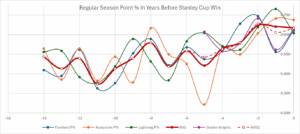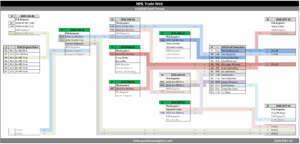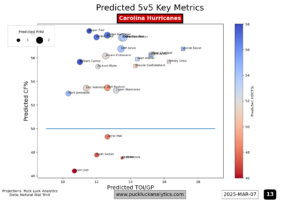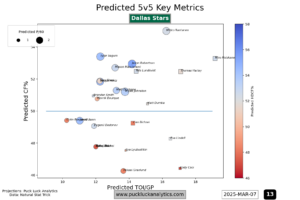Barry Trotz sent shockwaves through the NHL this summer with an aggressive free agency period. The Nashville Predators caught some of the summer’s biggest fish, instantly upgrading their current roster. I took a look at their summer moves in a recent Roster Rumination post. The Predators look like a good, but but not great team going into the 2024-2025 season and, with plenty of veterans in key roles, age related decline will be something they need to manage carefully to avoid their window slamming shut relatively soon. Let’s build a Nashville Predators Roster Roadmap that lays out a plan to create a roster that can sustain a long contention window.
A couple of key points before we dive in. As with the other roster roadmaps I’ve done, we’ll use cohort theory and player tiers in the discussion and player info will be listed with the following details:
Position – Player (Age / Cap Hit / Years Remaining Under Contract)
Veteran Pack
Barry Trotz’s early moves as Predators GM have have given us very clear indication that he has no interest in a long, drawn out rebuild. The additions he made this summer were designed for contention in the short term and we’re going to keep that objective at the forefront as we start building the roster roadmap. The desire to build a contender no doubt originates around a trio of long time Predators:
F – Filip Forsberg (30 / $8.5MM / 6Y): Forsberg has been one of the NHL’s best goal scorers over the past few years. He’s scored 109 regular season goals over the past three seasons. 67 of those have come at 5v5 which ranks 11th among all skaters. Now cresting 30, we should expect age to start reducing his impact but it will most likely be quite gradual over the next few seasons.
D – Roman Josi (34 / $9.059MM / 4Y): Josi is one of the league’s top offensive defensemen. He’s been runner up for the Norris Trophy twice in the last three seasons. At age 34, though, he’s got less runway left in his playing career than Forsberg. Age related decline could very well become noticeable within the next couple of seasons.
G – Juuse Saros (29 / $5.0MM–>$7.74MM / 1Y–>8Y): The Predators picked their goaltender for the next decade this summer, signing Saros to an 8 year extension. A consistently strong netminder, he gives the Predators a chance to win on most nights. The extension also precipitated the trade request from highly touted prospect Yaroslav Askarov that resulted in him being dealt to the Sharks.
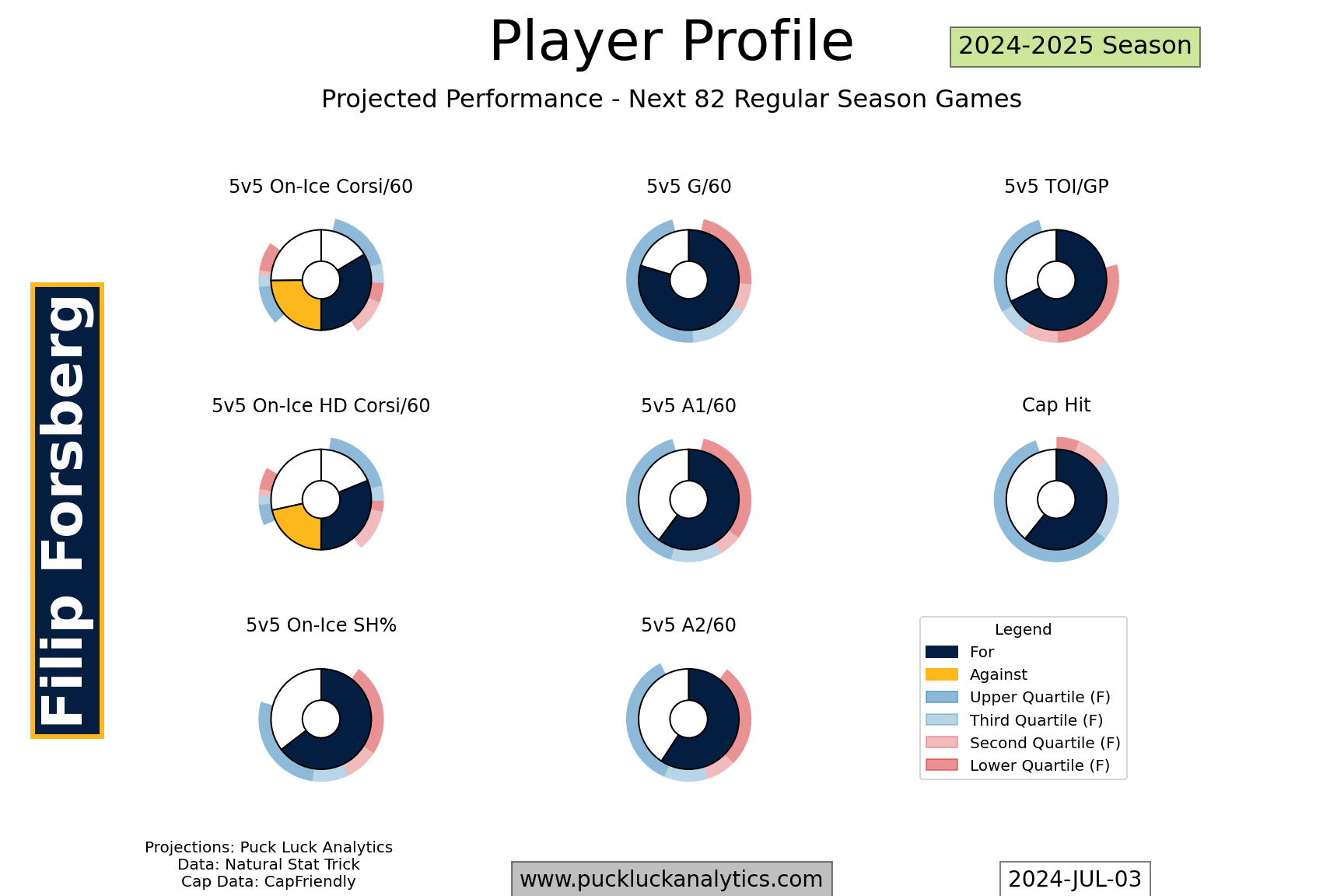
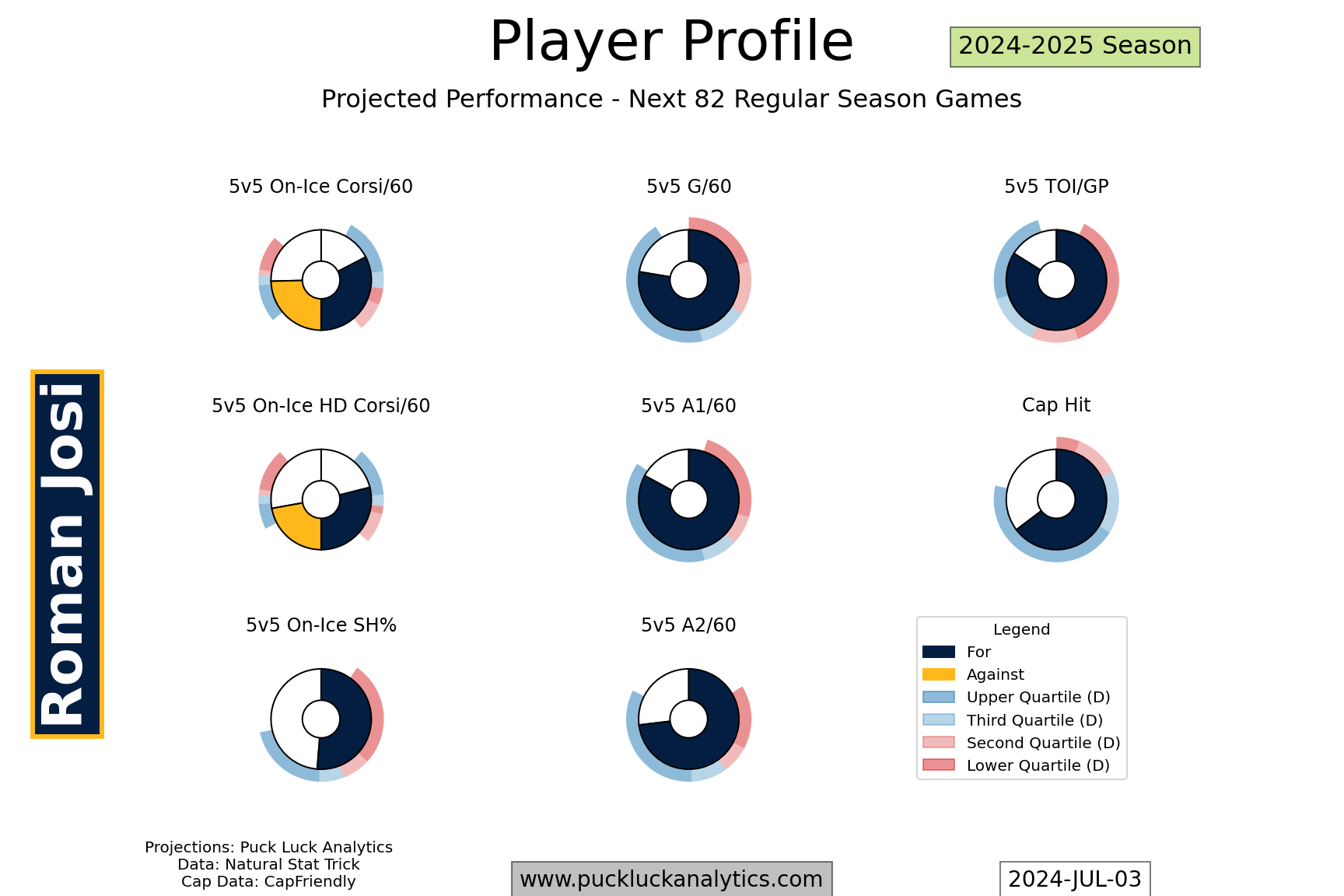
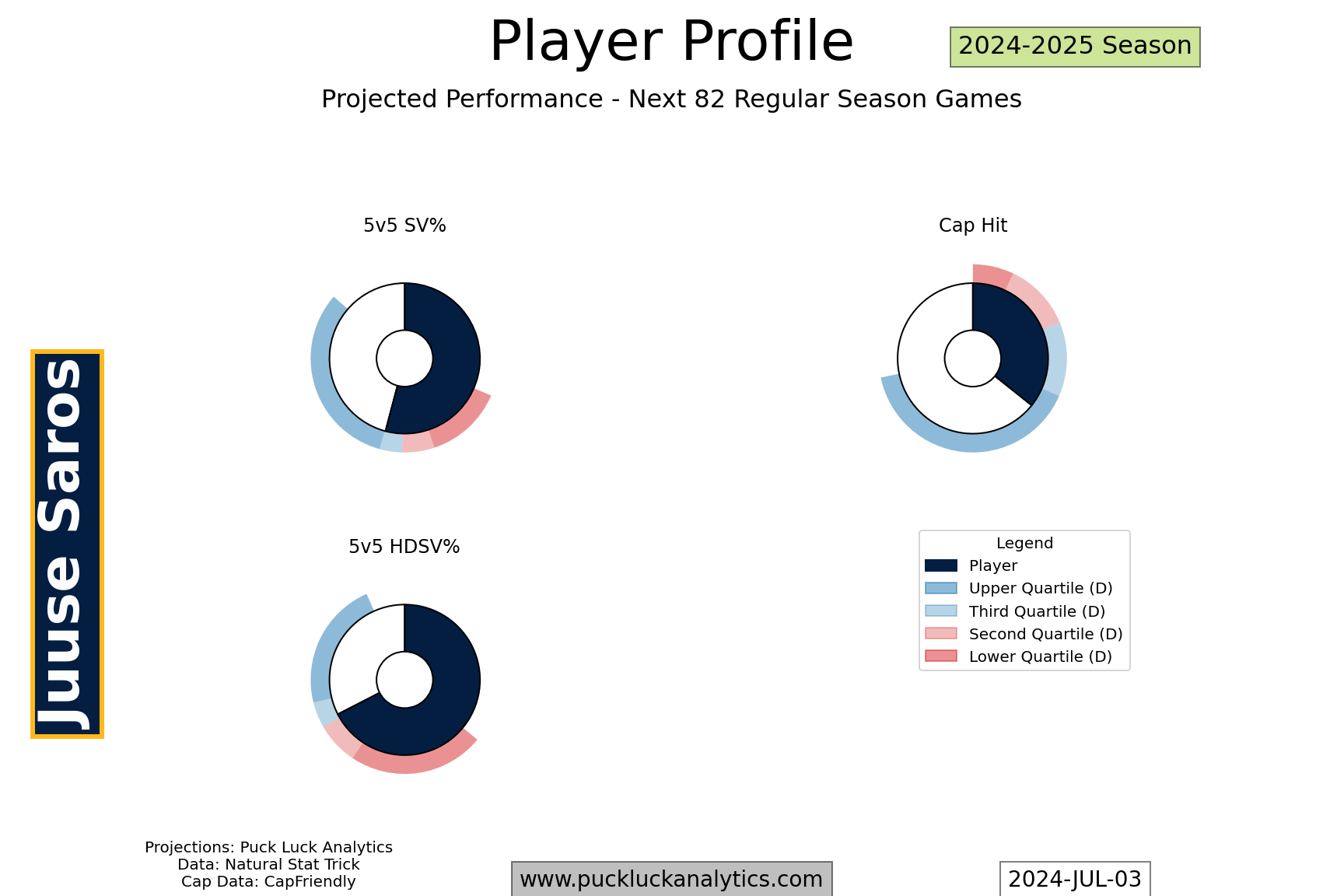
It’s fairly easy to see why Trotz is interesting in building around this trio. There’s a key cog at forward, defense and in goal. All three are excellent players and, while they are into the back half of their careers, its not much of a risk that their performance is going to fall off a cliff in the next couple of seasons. It’s actually a good chunk of a very good veteran cohort. A couple more forwards would round it out nicely.
While the trio above was leading the Predators to the playoffs last season, they just snuck in as a wild card team. Their scoring depth dropped off fairly quickly after their top few players. It seems clear that Barry Trotz recognized that and one objective this summer was to surround the Preds’ stars with more supporting talent. The Predators made three big free agent signings on July 1 that did just that, also rounding out a complete veteran cohort in the process:
F – Steven Stamkos (34 / $8.0MM / 4Y): Among the leagues best snipers at his peak, Stamkos is entering the twilight of his career. He’s still a valuable contributor, although the $8MM cap hit is a big price tag. The two time cup champ adds some firepower to the Preds roster alongside Forsberg.
F -Jonathan Marchessault (33 / $5.5MM / 5Y): Another cup champion, Marchessault also had to find a new home this summer with the Golden Knights ready to move on. He’s another option that should slot into the Preds top six.
D – Brady Skjei (30 / $7.0MM / 7Y): Brady Skjei adds a reliable, veteran defenseman to play in the Predators’ top four. Strong possession metrics and 5v5 production should provide some added offense from the blue line.
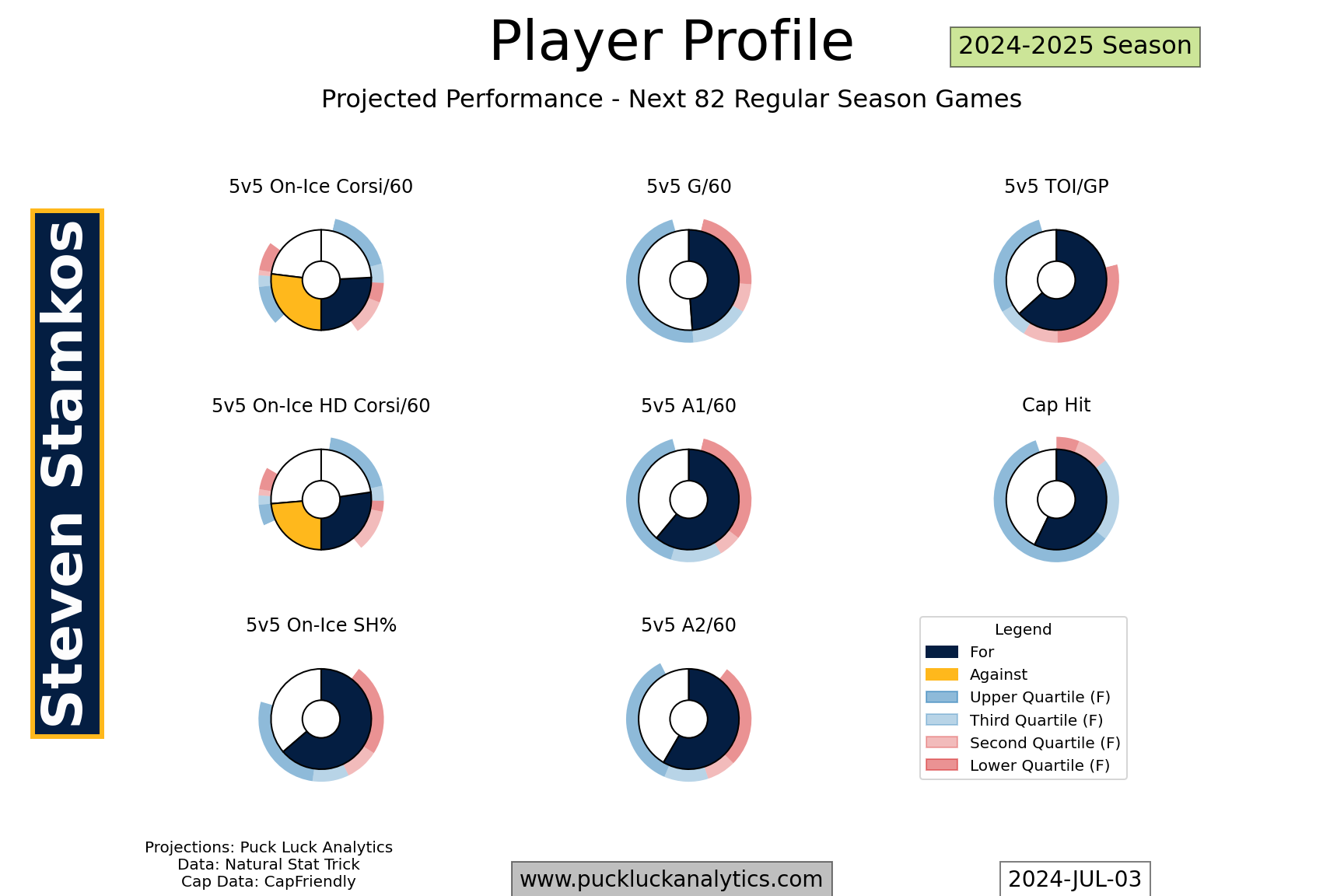
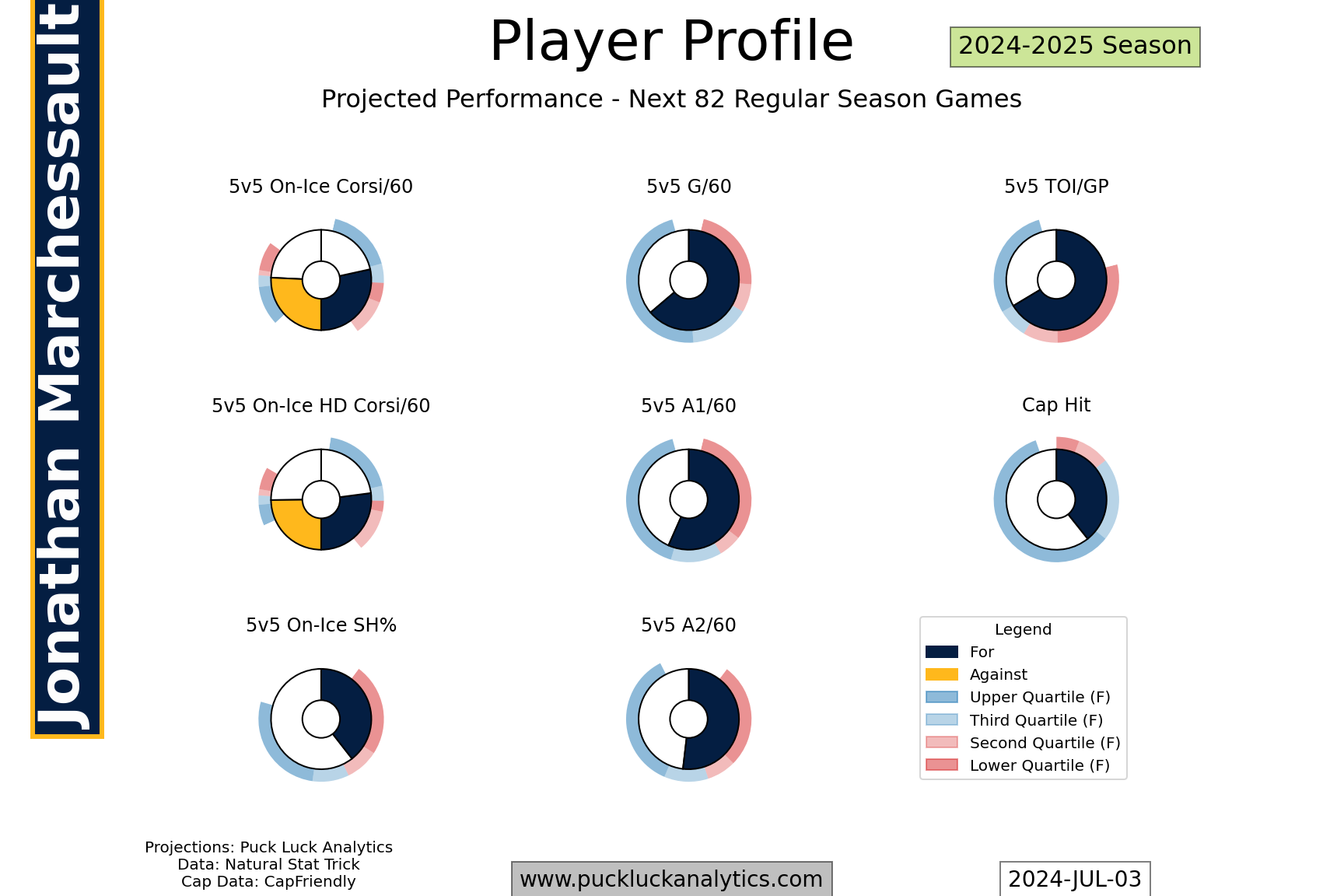
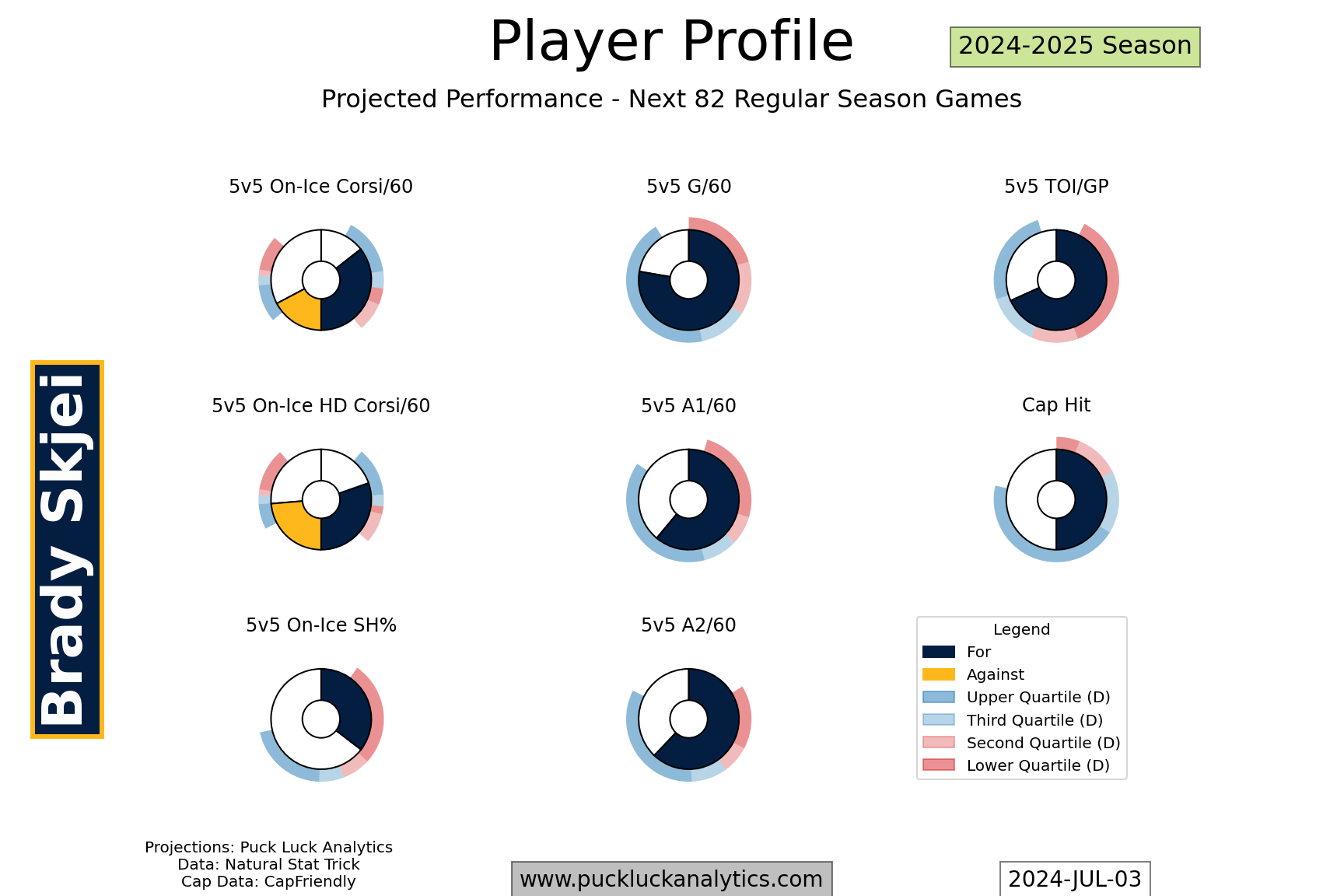
The summertime additions certainly gave the Predators a much needed boost to their depth. Not only will the addition of Stamkos, Marchessault and Skjei add skill to the top half of the lineup, it will push others down the lineup into roles where they can excel more easily. On the whole, it should be a boon for Nashville’s aspirations this season.
That boost came with a cost though. The six players above are under contract for roughly 50% of Nashville’s cap space for the next four seasons. Let that sink in. Half their cap space is committed to a group of six players currently between the ages of 29 and 34. By the time Josi and Stamkos come off the books in four years, the group will be aged 33-38. These are good players. They are most likely going to continue to be good NHLers over that time. But age effects are real and the collective age of this group going to eat away at this group’s impact as a whole, all while occupying half the team’s cap space.
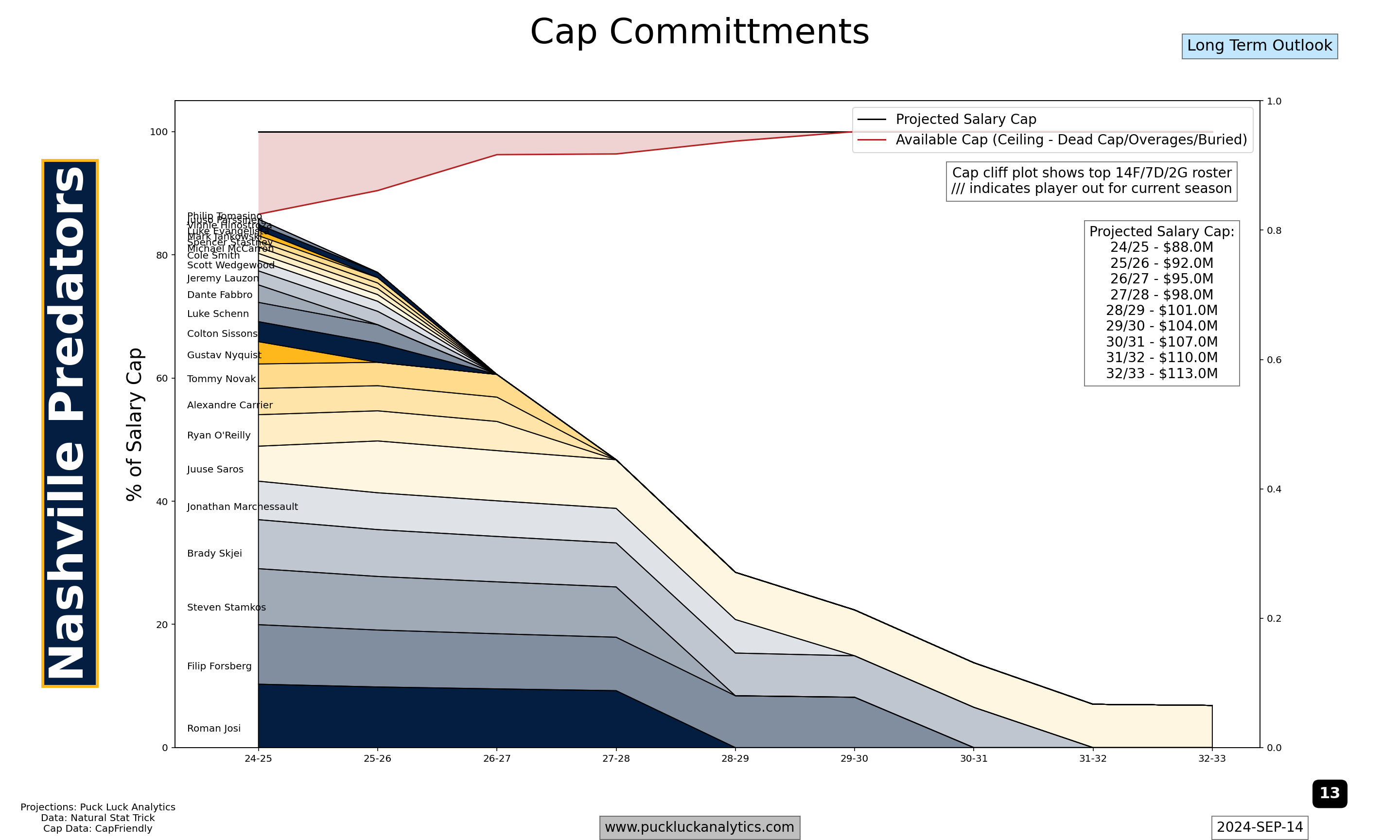
This is where the challenge appears in crafting a roster roadmap for the Predators. How can we build a younger cohort that can supplement the veteran group in the short term and extend the contention window in the long term?
Nashville Predators Roster Roadmap
We have a veteran cohort, as discussed above, that is going to lead the team in the short term. We now need to find a suitable group that can form the nucleus of a younger cohort. There’s a smattering of players in their late 20s on the roster, but that doesn’t fit our need. We want a group that has some natural development left to offset the declining impact we’re expecting to see from the veteran cohort. That means we’re going to look to players under age 25 to find a suitable starting point.
The first option is to start with a group of young players that have spent time on the Predators NHL roster. There’s a group of three forwards age 22-23 for us to start with:
F – Philip Tomasino (23 / RFA / RFA): 2019 24th overall pick Tomasino has had a hard time solidifying an NHL role. After playing 76 NHL games in his rookie season, he only played 72 in the next two seasons combined. His production took a big hit in his sophomore season, when he also saw heavier usage, so it looks like seasons 1 and 3 are a better indicator of his impact. He looks likely to be a Contributor Tier forward through his prime, with some upside potential to make the Support Tier.
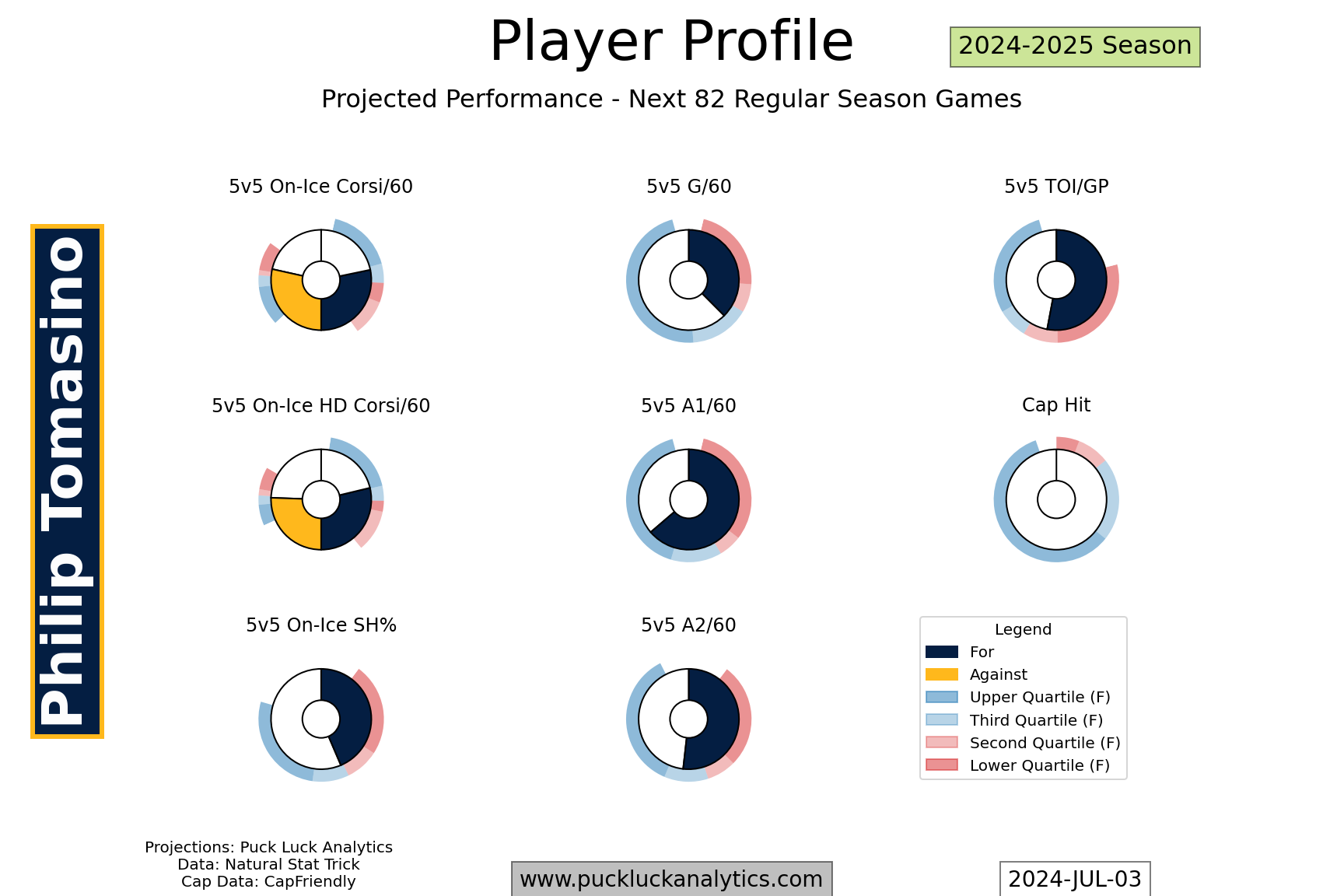
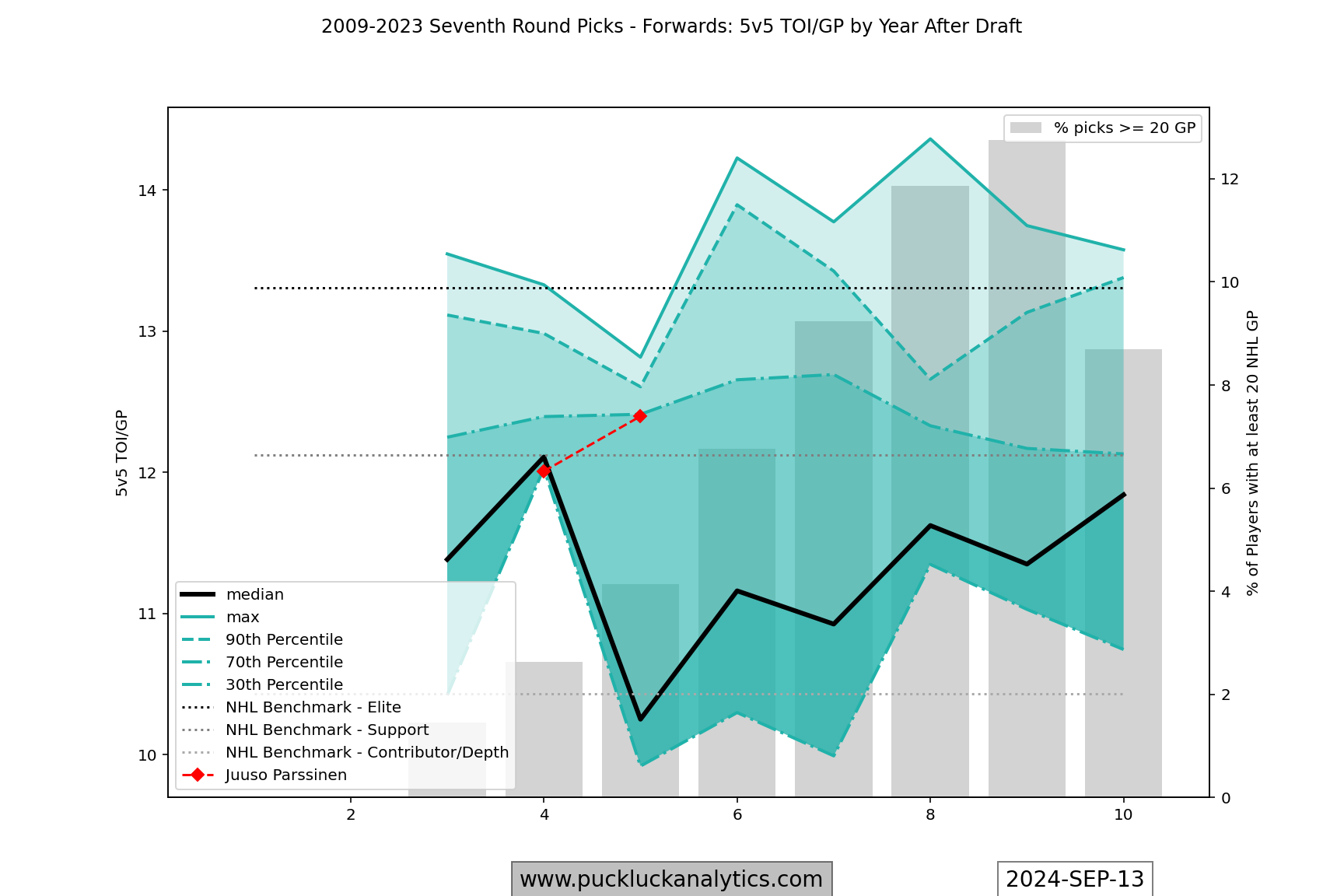
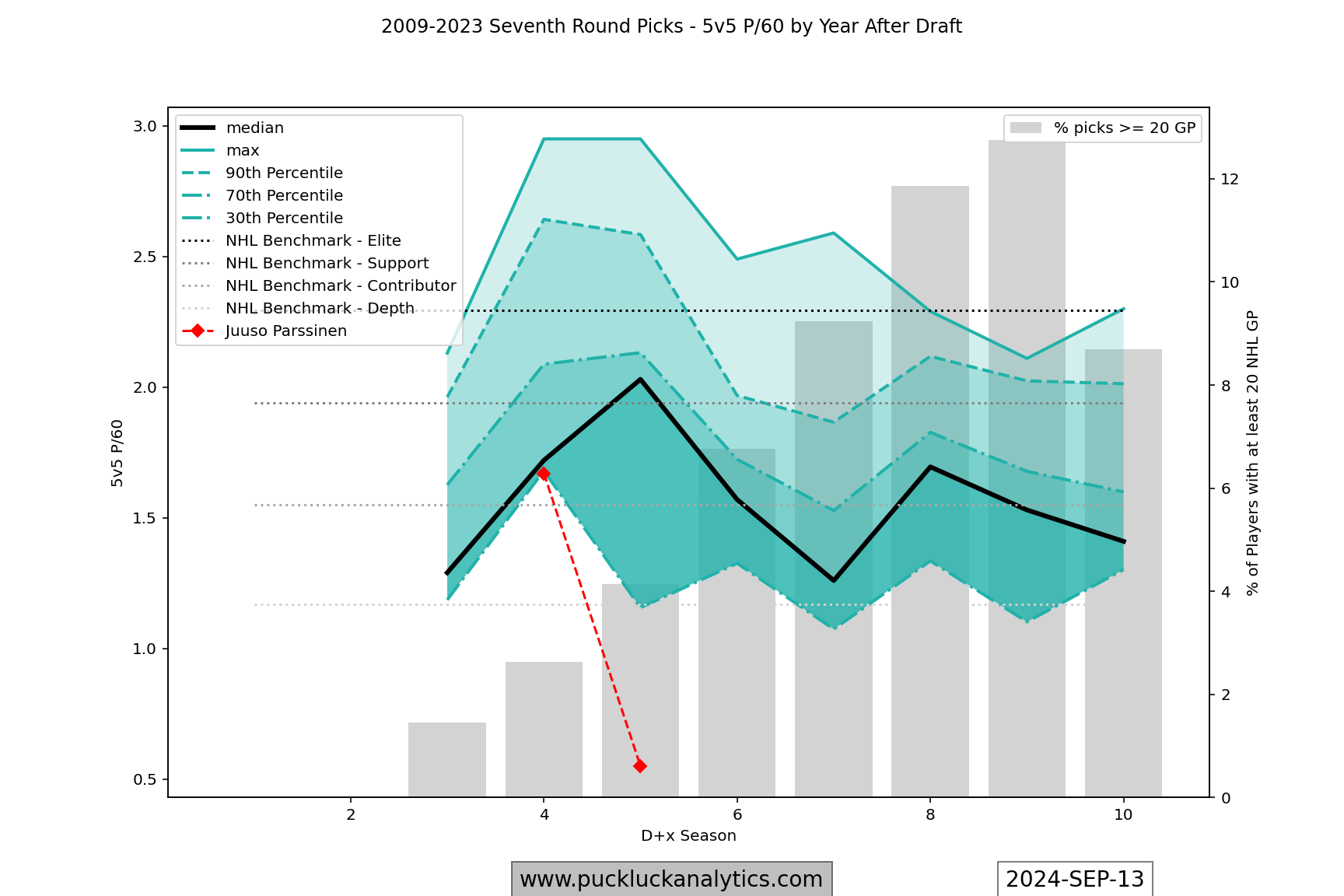
F – Luke Evangelista (22 / $797k / 1Y): Evangelista entered the NHL hot, to the extent he is the highest producing second round pick in his D+3 season in the last 15 years. That was a sample size of only 24 games though and he came back to earth a bit in his 80 game sophomore campaign. Like Tomasino, it looks likely that he’ll be a Contributor Tier forward through his prime with some upside potential.
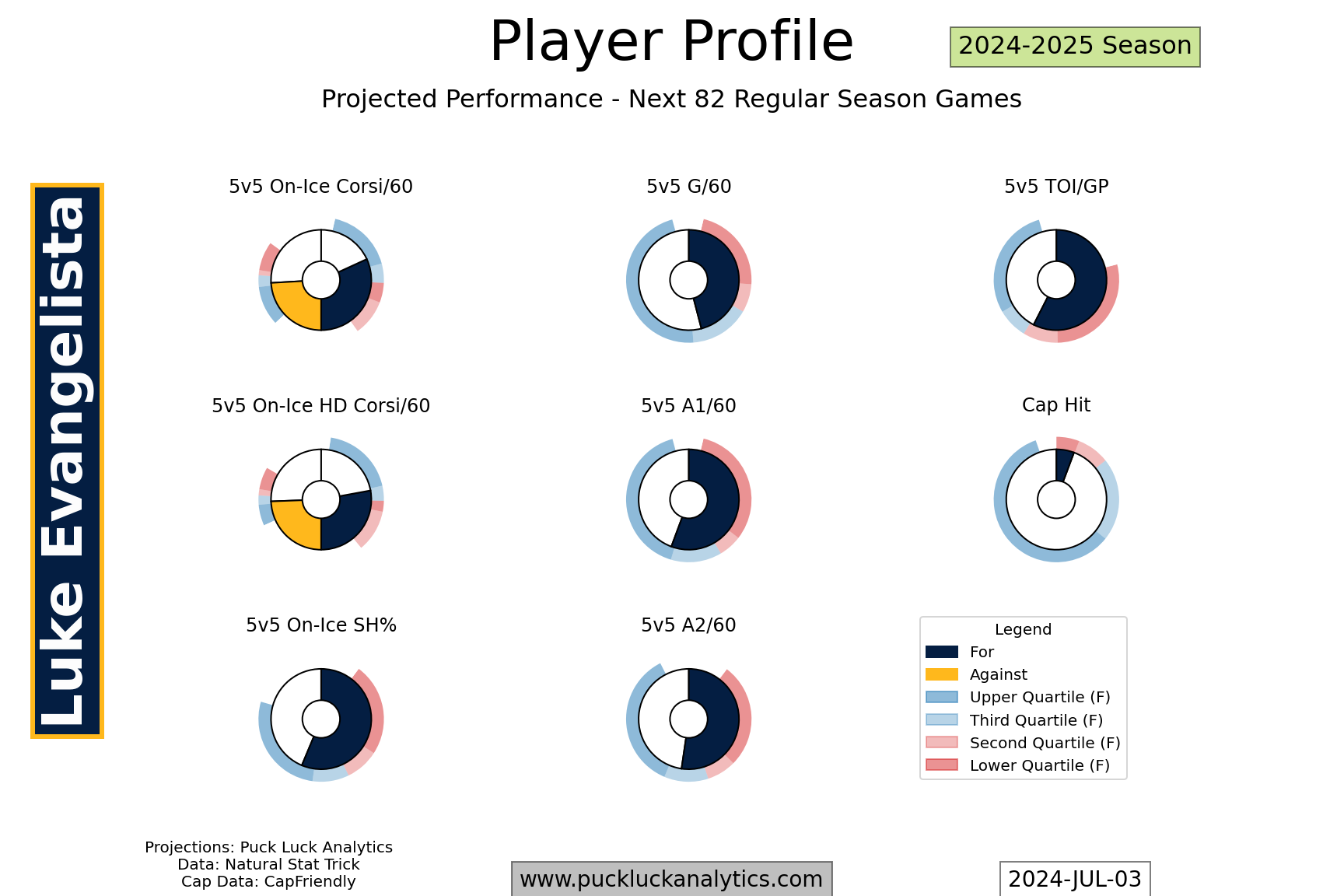
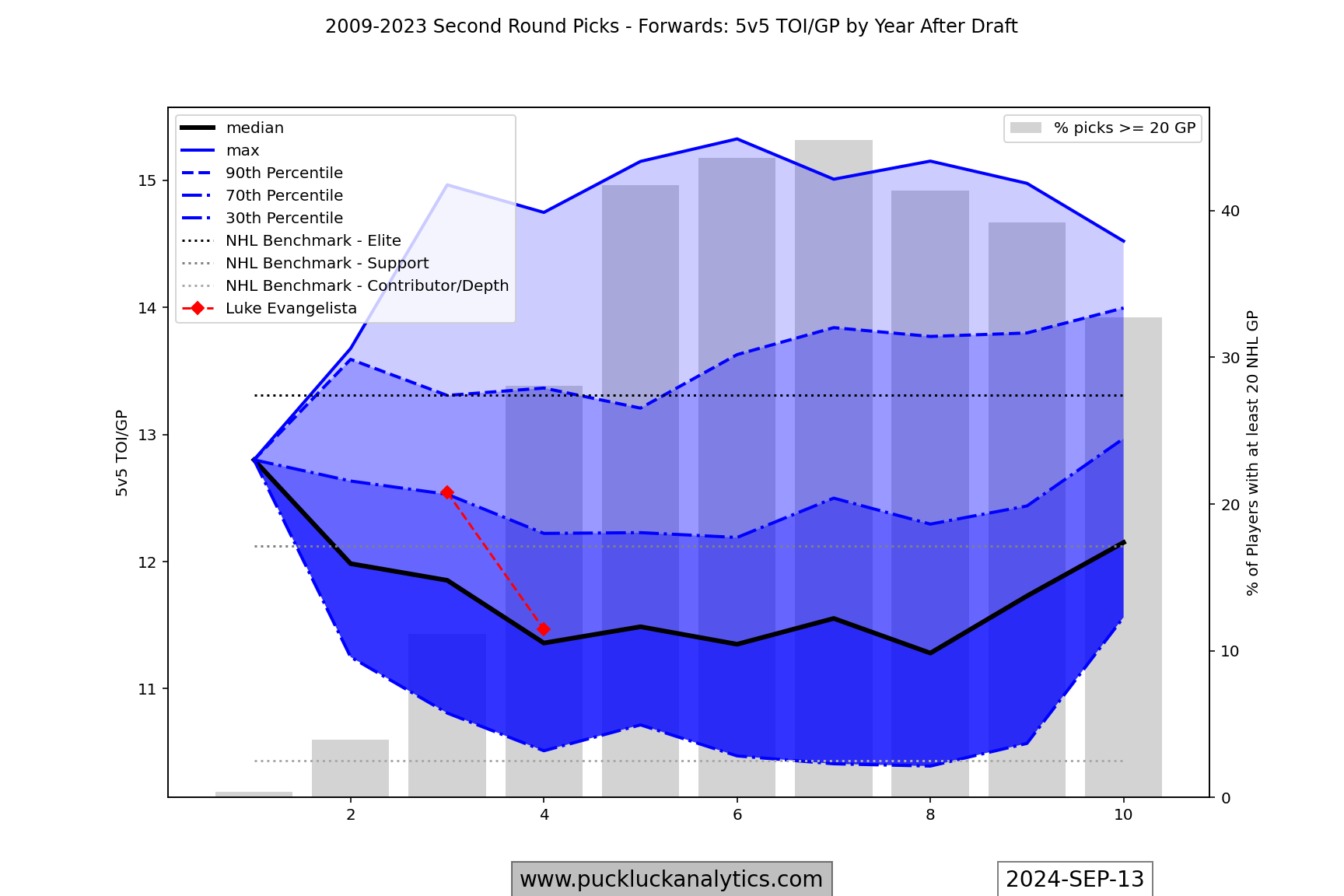
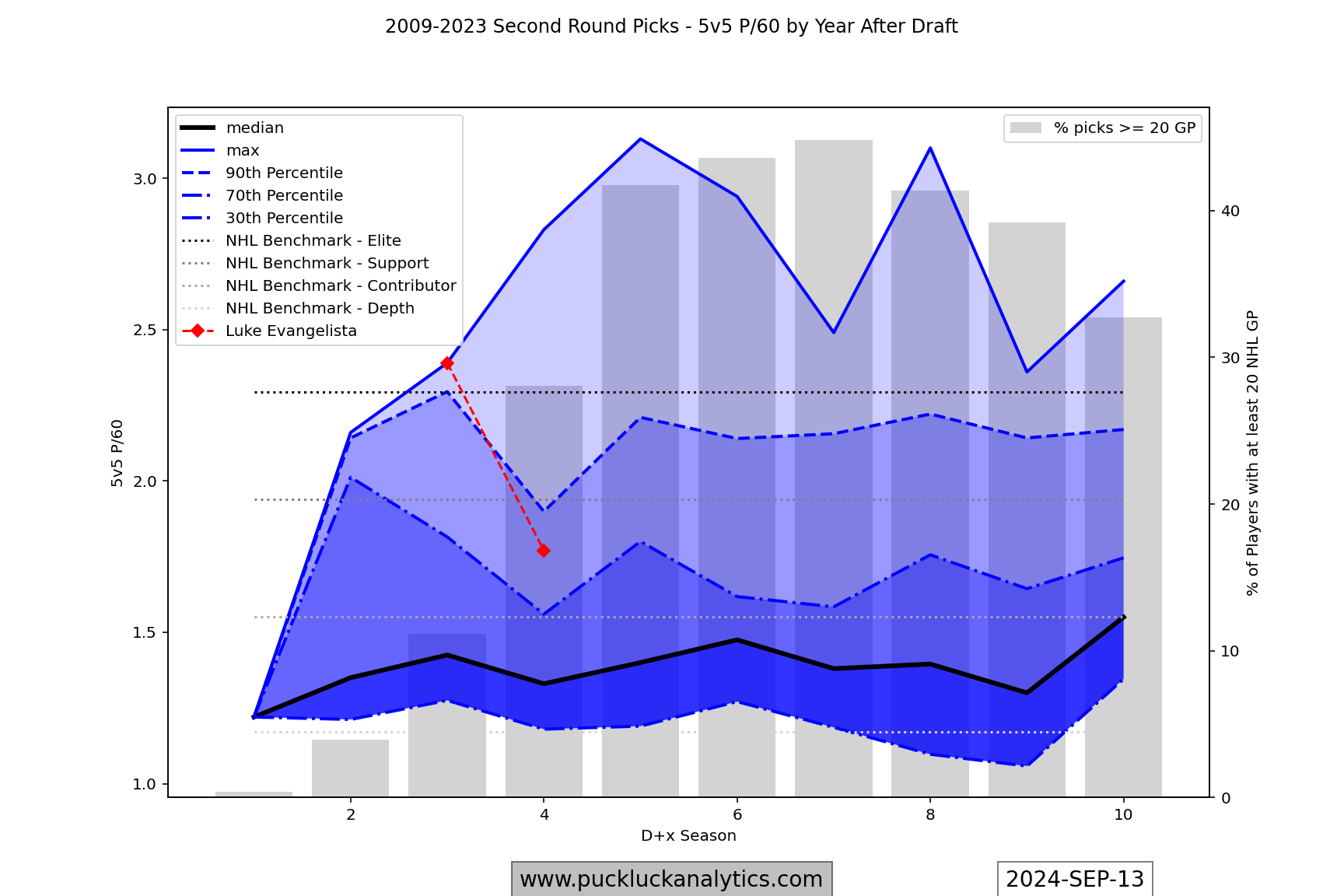
F – Juuso Parssinen (23 / $775k / 1Y): Parssinen had the long road to the NHL as a 7th round pick but he’s made it and stuck around for a couple of seasons. His production is trending in the wrong direction though. This season should tell us more, but right now, it looks like we should be happy if he can sustain a Depth Tier level through his prime. Perhaps he can be a useful bottom six forward, but there’s not enough here to expect him to be a suitable player for a primary cohort.
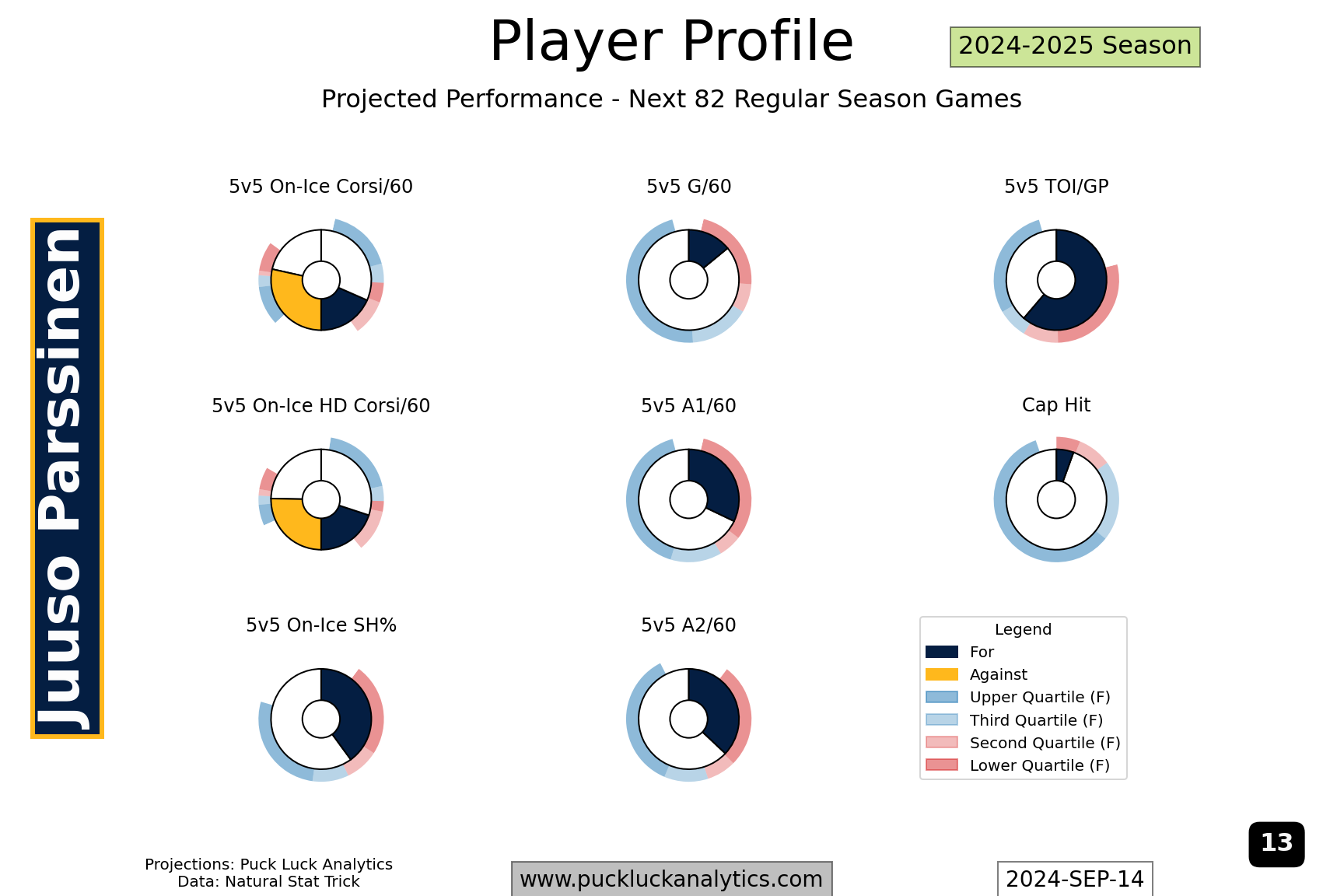
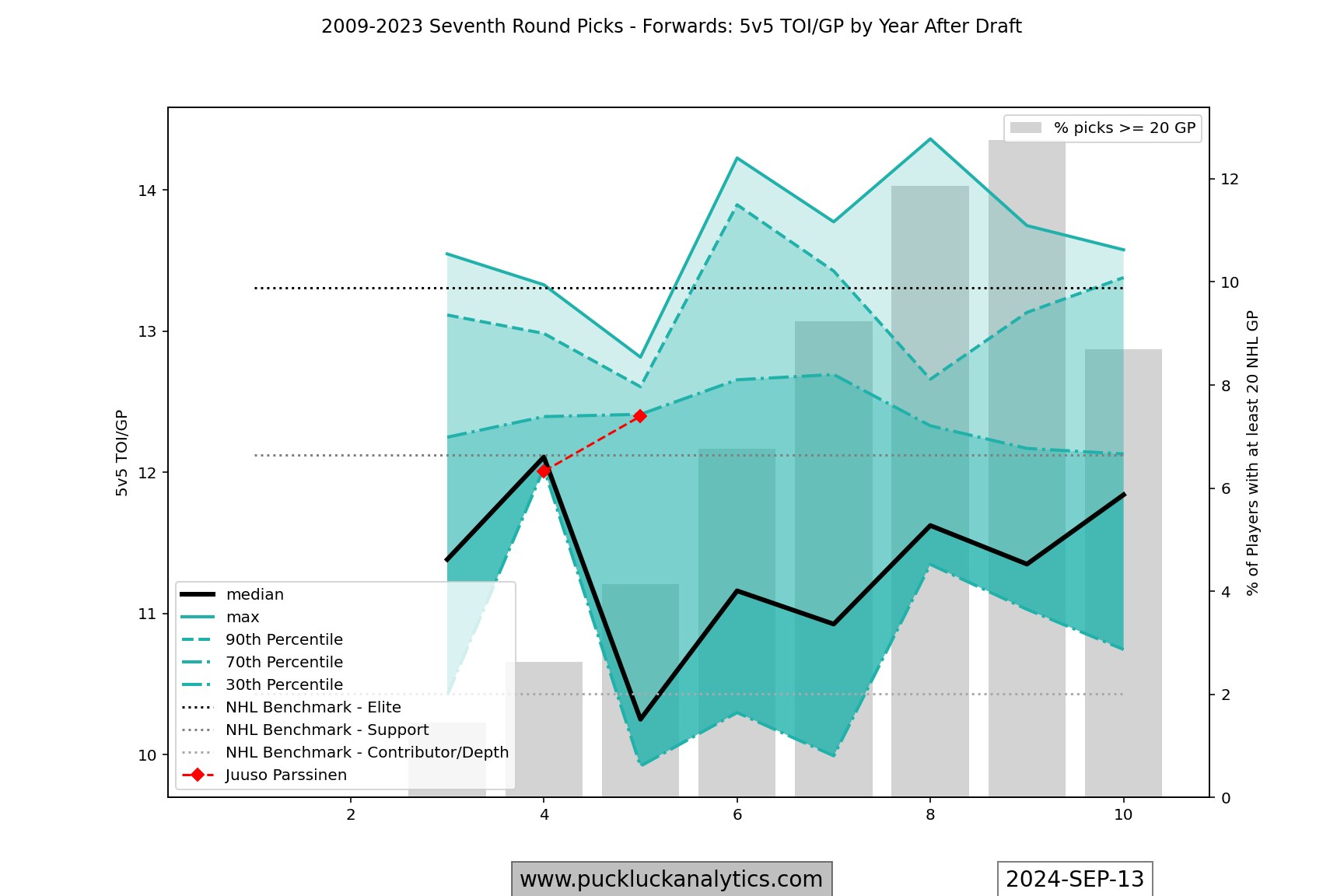
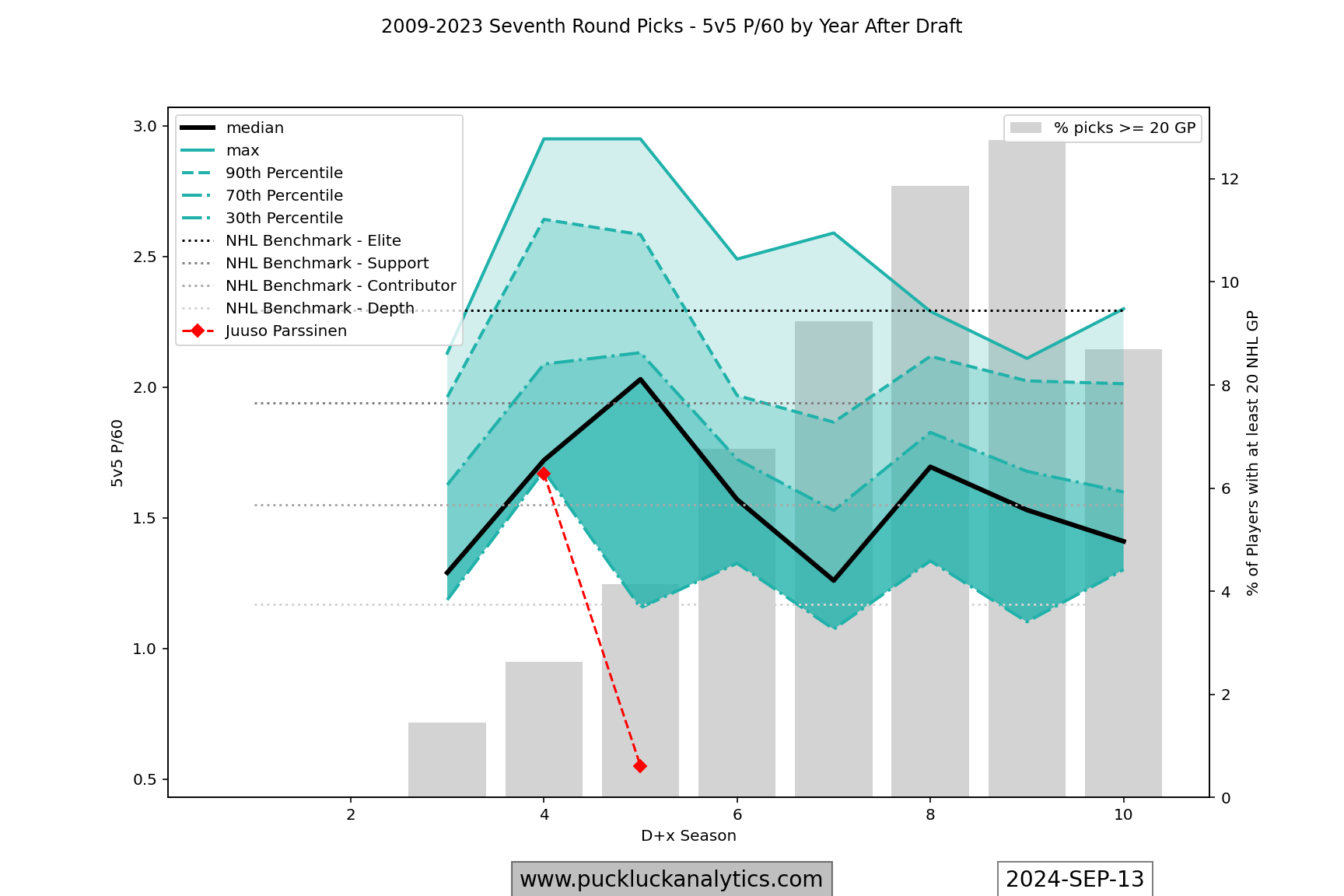
Unfortunately, a couple of Contributor Tier forwards and a Depth Tier forward is not much to get excited about as the starting point for a contention cohort. There isn’t much else in the system in a close age range to supplement them either. These three look like they could be good compliments to the veteran cohort in the short term, but eventually taking over as the main drivers of the roster seems like wishful thinking. We need to find a different group.
Development Cohort
Hockey Prospecting ranks the Predators as the 15th best prospect pool in the NHL. Not outstanding but there’s reason for optimism when we look a bit closer. The Predators have a group at the top of their prospect pool that have decent star potential and there are enough of them that it’s reasonable to think that a few will hit as stars. Not only that, but the top prospects in the system are primary from the 2023 and 2024 drafts. The Predators have also accumulated a number of high picks for the 2025 draft. It looks like there’s something to build a cohort around if we focus on the 2021-2025 drafts.
Yes, we’re bending the cohort theory rules a bit here with a 5 year cohort. There’s reason for that though. Defenseman Ryan Ufko is arguably the Predators top prospect and he was drafted in 2021. We also want to include the 2025 draft in which Nashville has 3 first round picks, 2 second round picks and 2 third round picks. There’s also no identifiable primary cohort between the veteran cohort and the developing cohort. We need a sizable group to fill the hole created by the missing cohort and we need the group to start hitting the NHL soon.
The Predators top seven prospects give us a good starting point for the developing cohort. From Hockey Prospecting’s model, they range in star potential from 13-42% and NHLer potential from 46-70%. There aren’t any slam dunks here, but there’s enough potential that a couple of them should hit as stars. We can also pencil in the team’s top 2025 picks to round out the group.
| F – Joakim Kemell | F – Matthew Wood | D – Ryan Ufko |
| F – Teddy Stiga | F – Miguel Marques | D – Tanner Molendyk |
| F – Yegor Surin | F – 2025 1st RD Pick (NSH) | D – 2025 1st RD Pick (TBL) |
Bridging the Gap
Our challenge now is finding a way to connect the veteran and developing cohorts. Of course, there are some notable players on the current roster that we haven’t looked at yet. Let’s start there, since they’ll be important pieces in putting together a plan to build a sustainably competitive roster without compromising the objective of competing in the short term.
F – Ryan O’Reilly (33 / $4.5MM / 3Y): Another useful piece on the older end of the veteran cohort age bracket. Remember how we found a complete veteran cohort with the six players discussed off the top? More players in this age group creates a bigger challenge to offset age related decline.
F – Tommy Novak (27 / $3.5MM / 3Y): Novak has finally secured a nice paycheck for himself. He’s a capable NHLer, but he’s not moving the needle in a big way. At least he’s a few years away from 30.
F – Gustav Nyquist (35 / $3.185MM / 1Y): 35 years old and entering the final year of his deal. You can probably guess where Nyquist fits in the long term plan.
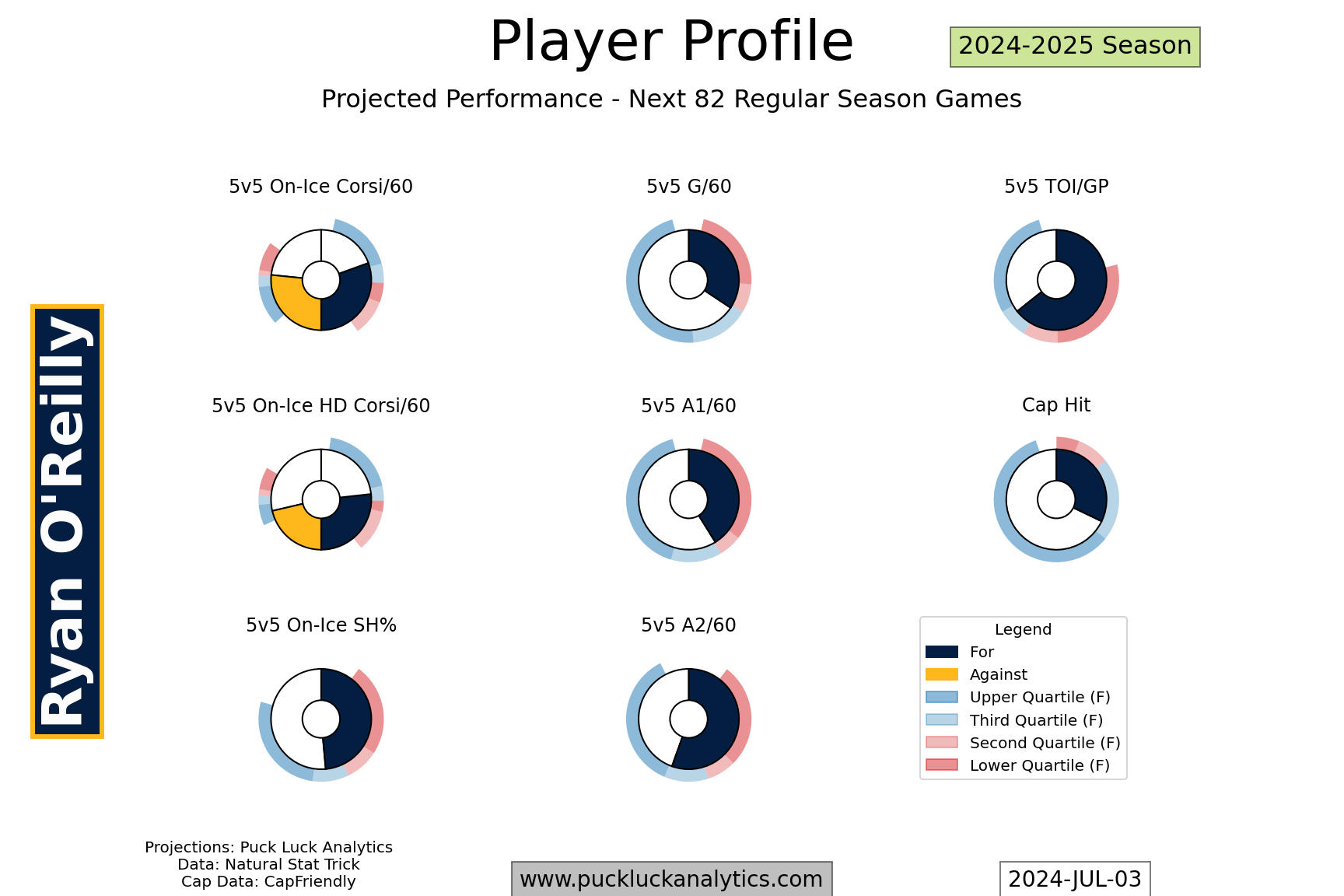
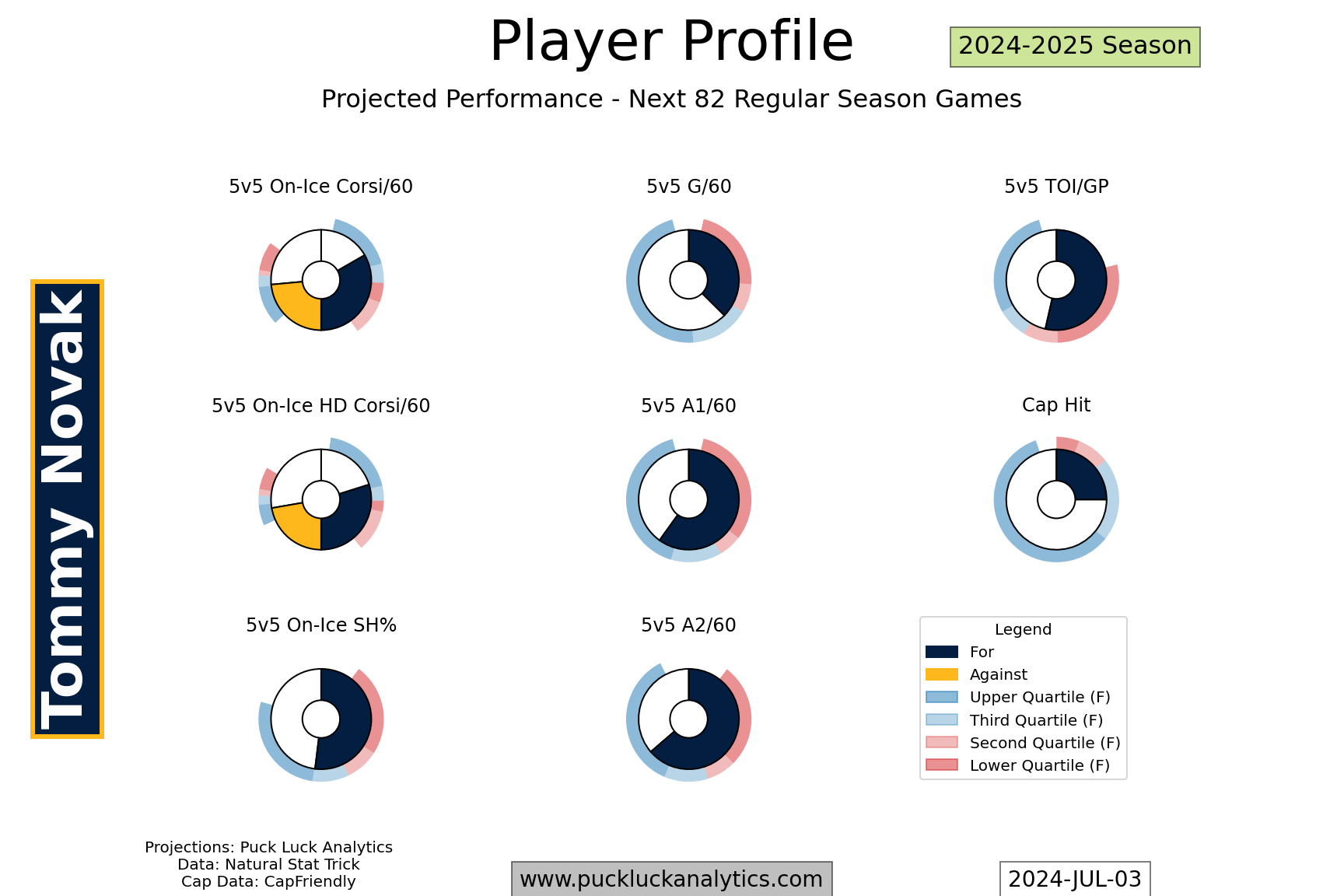
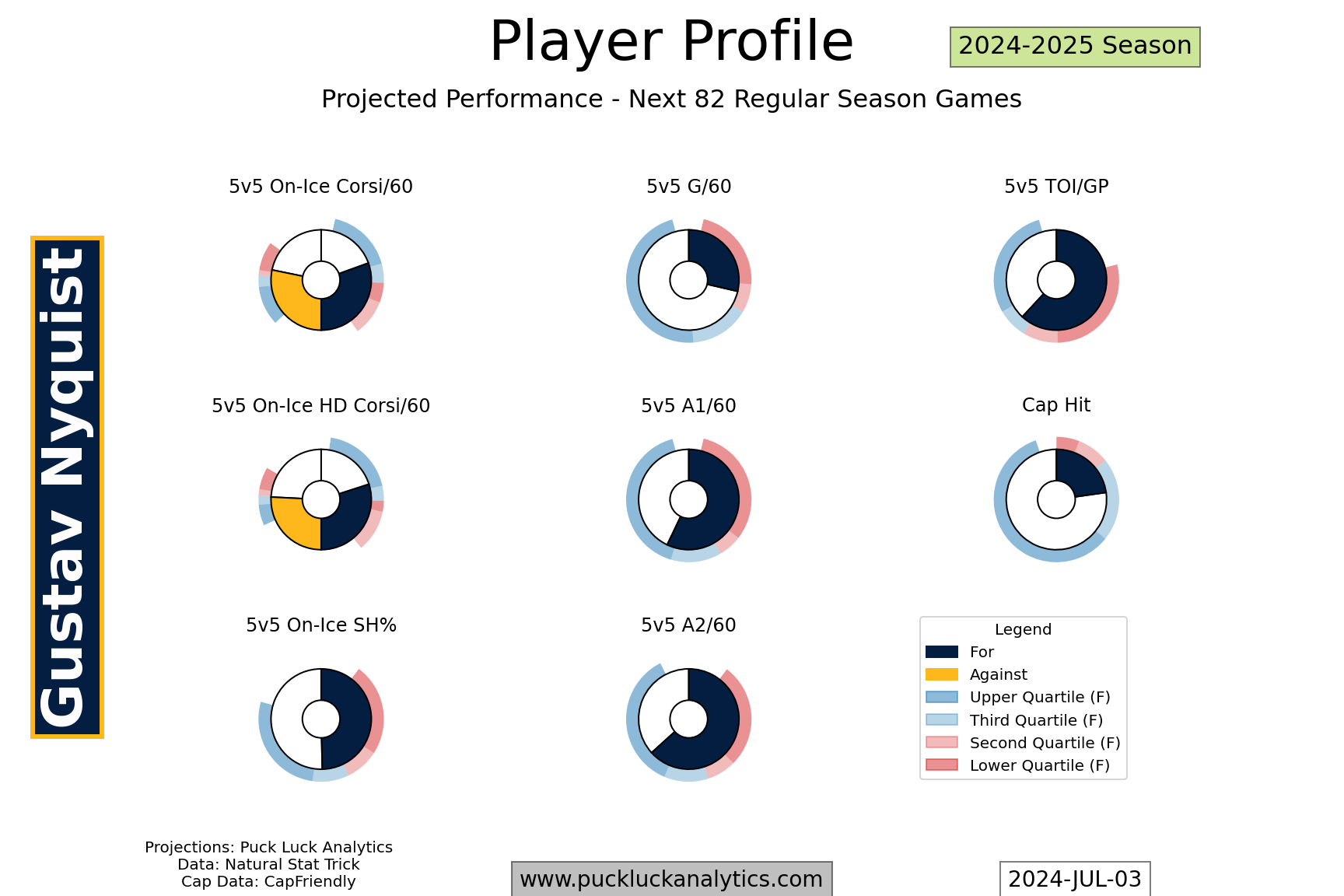
F – Colton Sissons (30 / $2.857 / 2Y): A depth player eating up nearly $3MM cap space.
F – Cole Smith (28 / $1.0MM / 2Y): Another depth player, eating up only $1MM cap space.
D – Alex Carrier (27 / $3.75MM / 3Y): A useful piece to fill out the current D corps but nowhere close to elite.
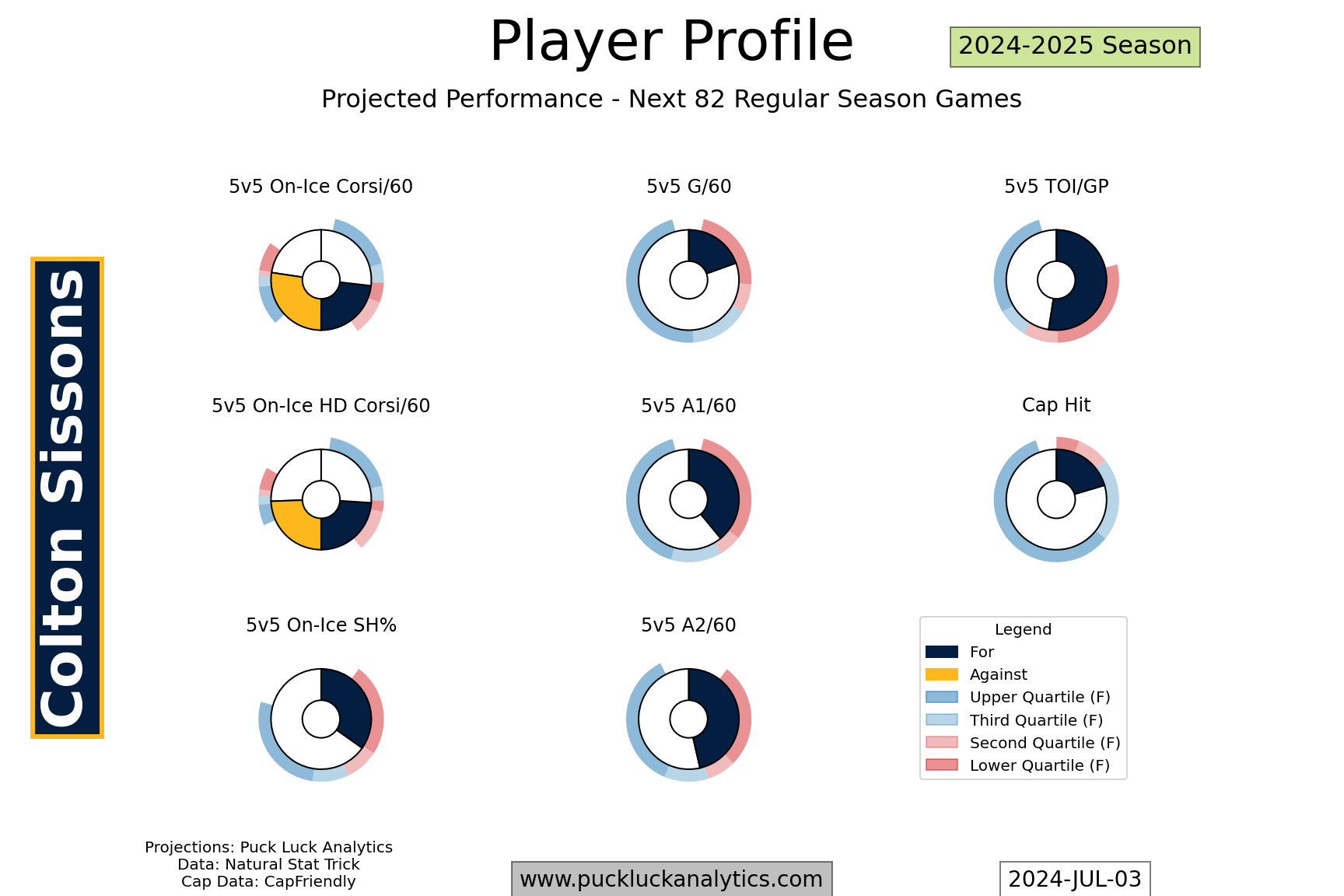
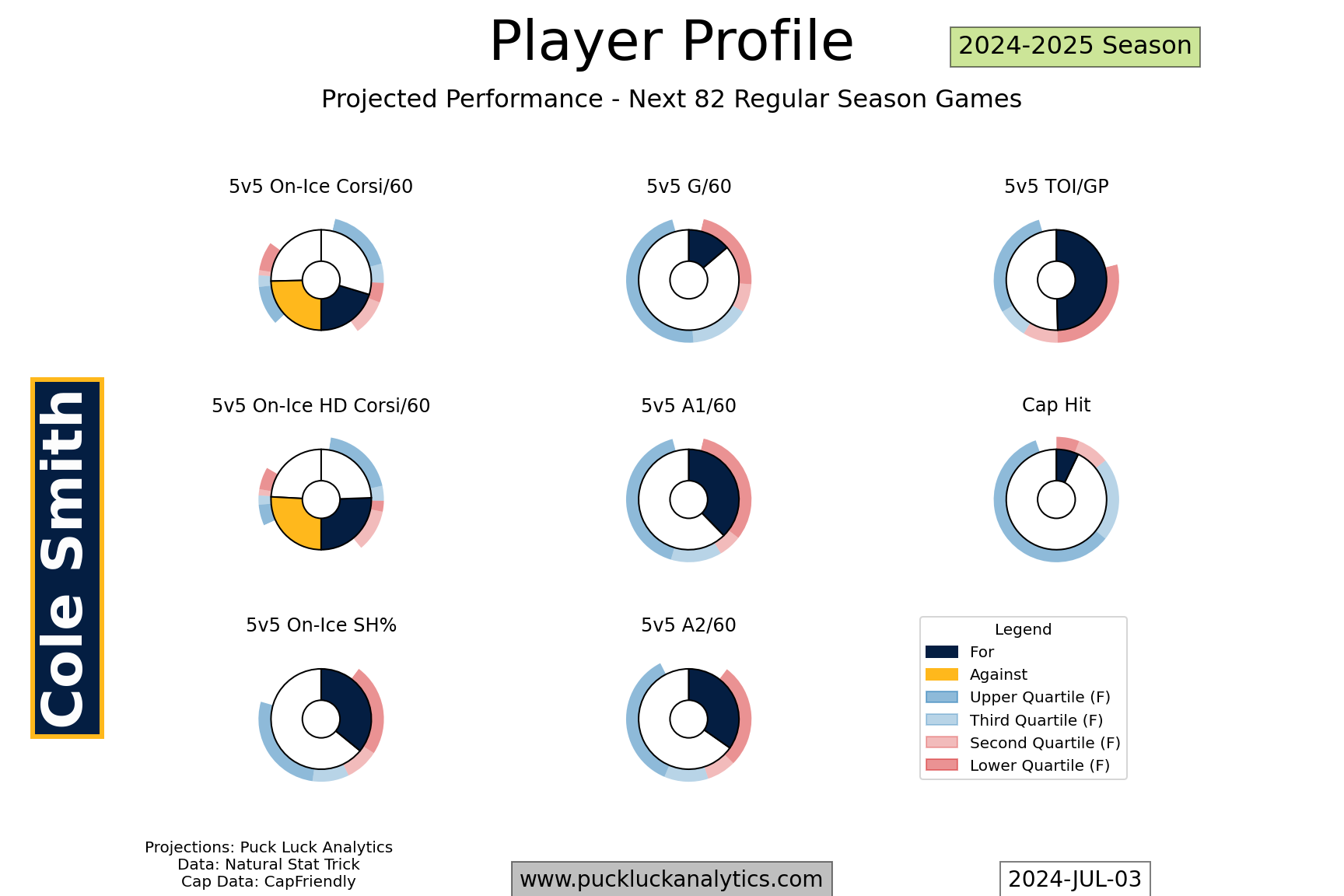
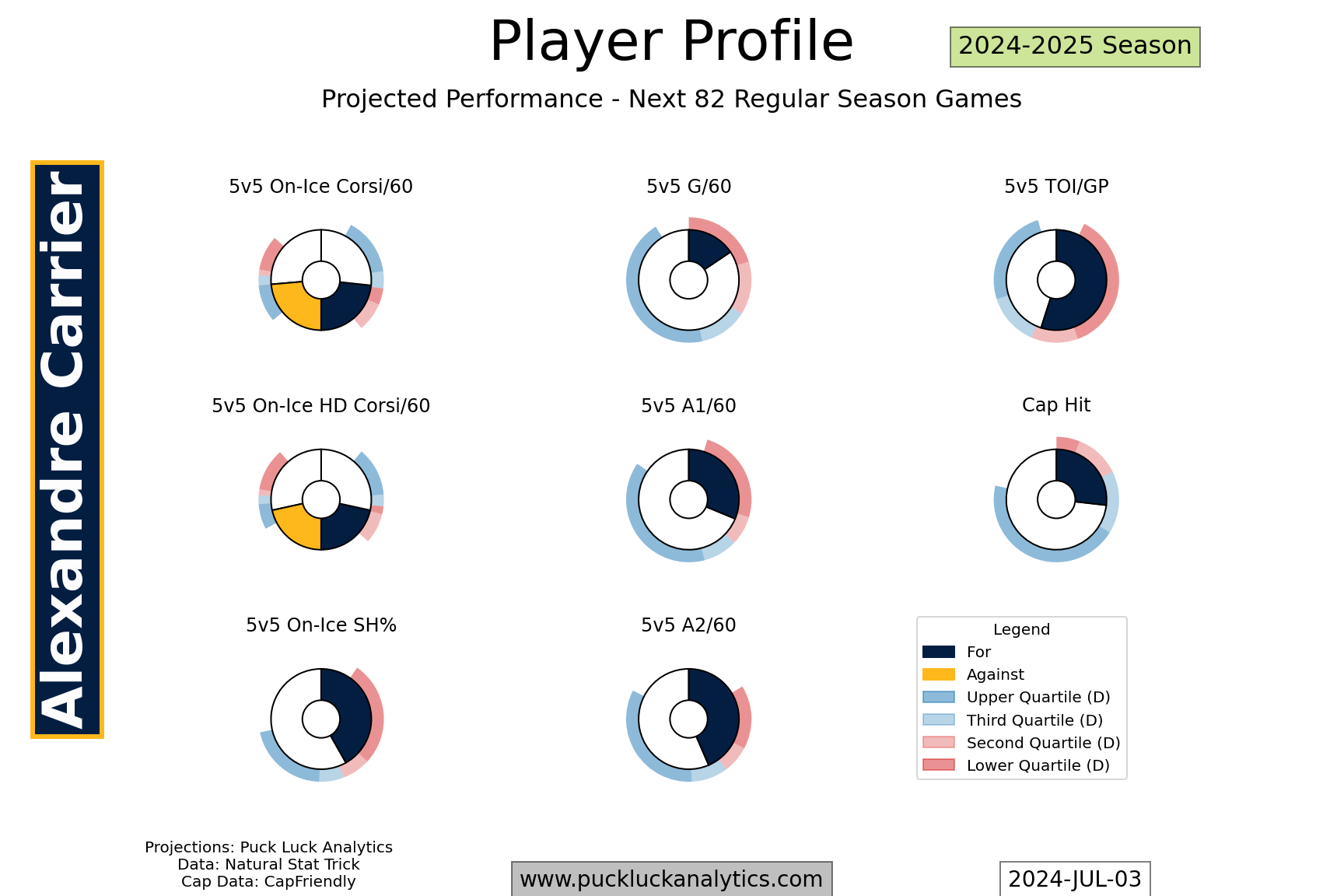
D – Luke Schenn (34 / $2.75MM / 2Y): Yet another skater already in his mid 30s.
D – Dante Fabbro (26 / $2.5MM / 1Y): The youngest established NHL defenseman on the roster. Capable on the middle pair, probably better on the third pair.
D – Jeremy Lauzon (27 / $2.0MM / 2Y): In his late 20’s, Lauzon can hold down a bottom pair spot until we find a better option.
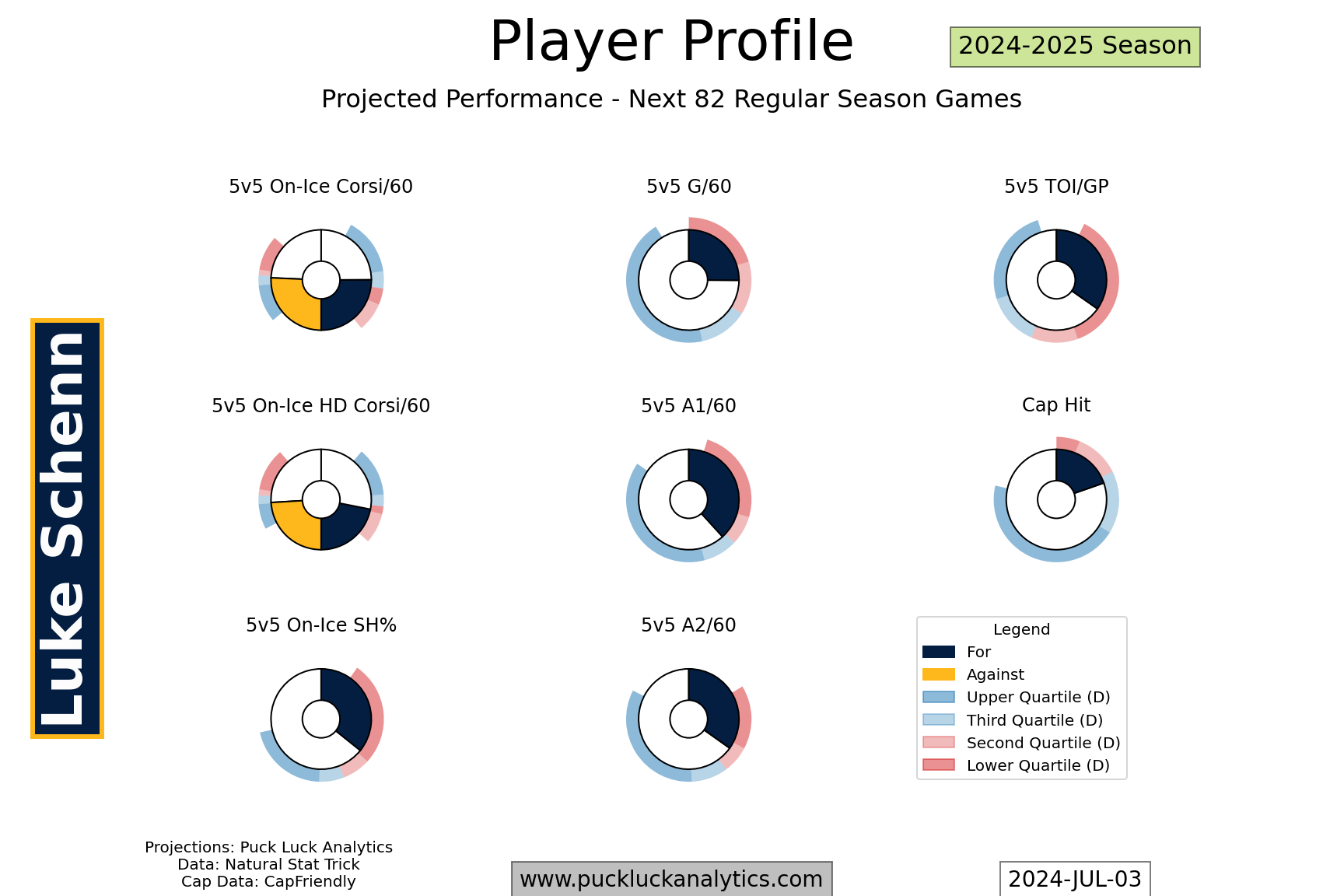
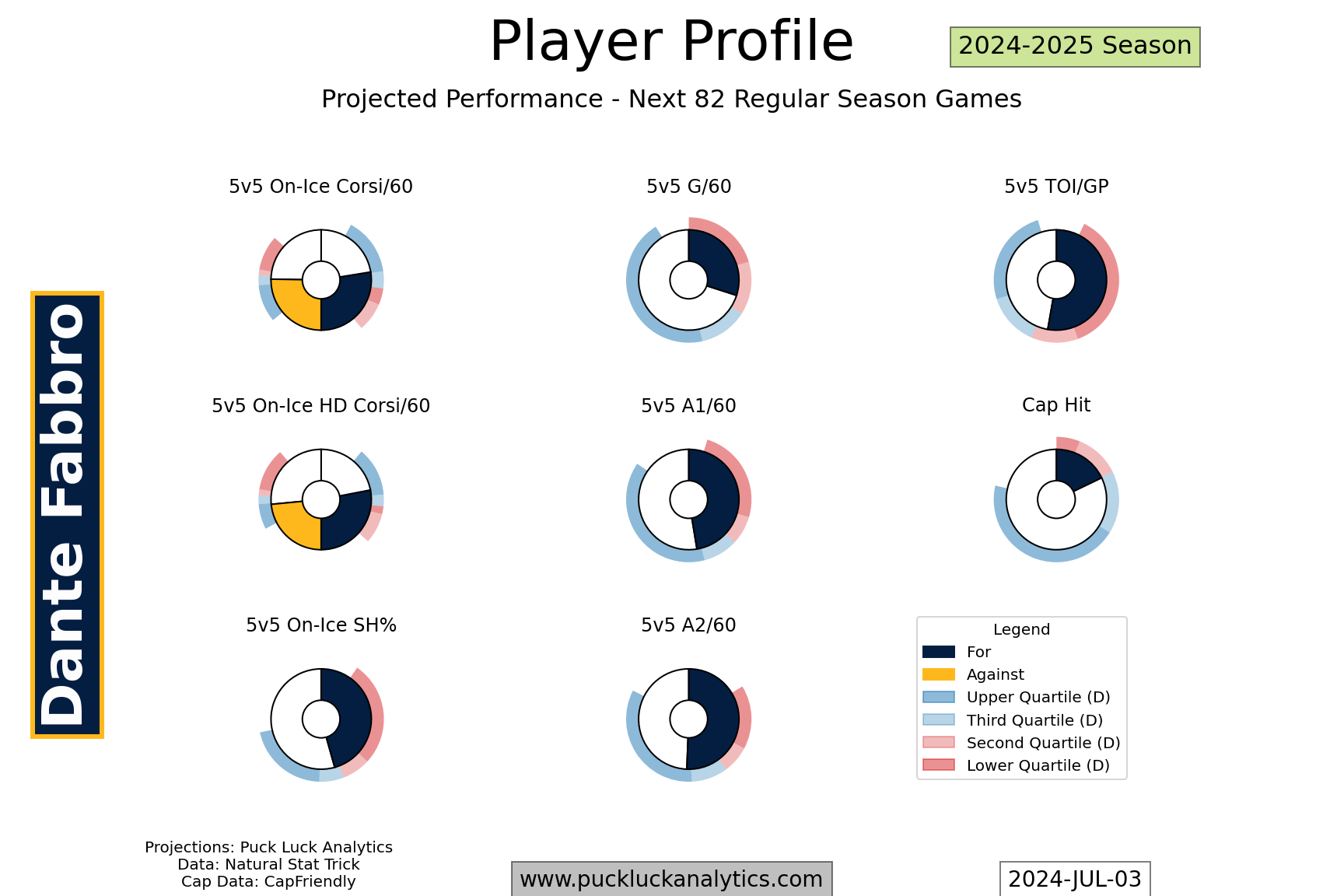
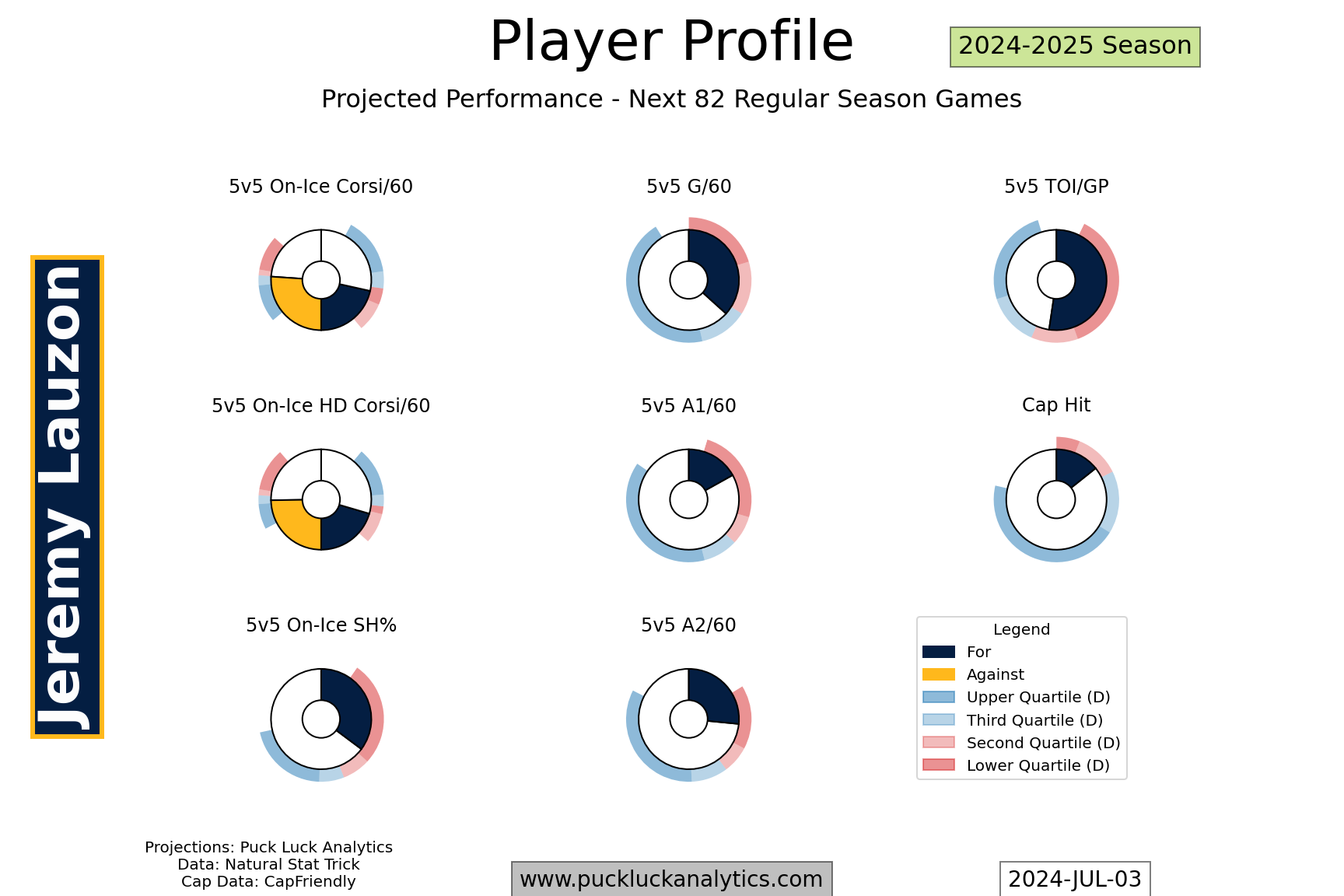
Acquisition Targets
There are two areas to focus on for acquiring players. First, we want to add to the current group to upgrade where possible or at least help balance out the inevitable age related decline the roster is facing. Second, we want to add to the developing cohort to build out a strong group that can become the focal point of the roster in five years or so. Here are some key acquisition targets:
2025 Draft Picks: The 2025 draft is the back end of the developing cohort. It our last chance to supplement the cohort through the draft. With seven picks in the first three rounds already, things already look pretty good here. Prospects are a game of probabilities though and more is always better.
2021-2024 Drafted Players: The rest of the developing cohort. If we can get our hands on a prospect that has elite potential and fits our cohort, we should jump at the chance. Anther high end D prospect and a high end forward prospect would give the group better odds of turning out the total impact we need.
Under 27 Skaters That Fit Current Roster Needs: While the Predators acquisitions this summer were a step in the right direction, the Predators are good but not great. There’s room for more talent on the roster to try to move toward true contender status. Josi and Skjei are strong top 4 defensemen but there’s room for one or two more defenders to set the team up better for playoff matchups. The top 6 forward group could stand an upgrade or two as well. Forsberg, Stamkos, and Marchessault should certainly be a part of it for the short term. The other three spots probably have room for improvement, either replacing the current players or bumping them down the depth chart. Any additions need to be young enough to help shift the collective age of the roster younger. Under 27 will at least avoid any immediate concerns with age related decline. Under 25 is preferable. These players can also be considered as potential pieces of the veteran cohort five years down the road when the developing cohort we’ve built hits their prime and becomes the focal point of the roster.
Trade Chips
We aren’t likely going to find the pieces above on the free agent market. That means we’re going to have to give up something in exchange. What are our best trade chips?
Tomasino/Evangelista/Parssinen: Yes, those three younger forwards that are stranded outside our cohorts. Tomasino was a first round pick. Evangelista and Parssinen had very strong starts to their NHL careers. It’s plausible that there are teams out there that would find it enticing to take a chance on one of these players in ‘change of scenery’ circumstances. What we want in return is an upgrade for the current roster, so we’d like to package another asset or two with one of these players to get a better player in return. Perhaps a player with a year or two left on their current contract that we don’t have to keep long term.
Players Over 25: Pretty well every player over age 25 has to be considered expendable. We have to reduce the size of the over 30 group. With a number of players in their late 20s, the over 30 crowd is set to grow if we don’t act. Forsberg, Josi and Saros are elite talents and we need them to anchor the roster until the top players in the developing cohort emerge at the NHL level. Forsberg and Josi are also the only players with trade protection. Everyone else can be moved. Unlike with the younger players, we can make a one for one trade for similar player a couple of years younger. Or we can move some of the veterans before their contracts run out to acquire prospects that fit in our developing cohort. A few more pieces from the 2021 or 2022 drafts would certainly be a benefit. The developing cohort is heavy on the younger end right now but we need it to start taking NHL roster spots soon.
2026-2029 Draft Picks: While we want to hang onto 2025 draft picks to round out the developing cohort, picks from the next few drafts fall between cohorts. These are expendable future assets that the Predators can use to package in trades.
Nashville Predators Roster Roadmap Summary

